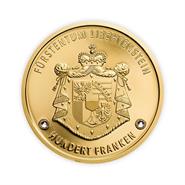Date : 16/07/2019

VADUZ, Liechtenstein, July 15 (KUNA) -- Liechtenstein Principality celebrates this year the 300th anniversary of its foundation by Holy Roman Emperor Charles VI in 1719 as a sovereign state.
The first thing that comes to mind when Liechtenstein is mentioned is its marvelous economic boom.
The world's sixth smallest state with an area of 160 km has the world's highest standards of living and one of the lowest unemployment rates.
As of 2014, Liechtenstein's gross domestic product (GDP) on a purchasing power parity basis was estimated at USD 4.978 billion. As of 2009 the estimate per capita was USD 139,100, the highest listed for the world.
In the past, the state's economy was dependent on agriculture sector: selling agricultural, livestock and dairy products.
Many of the country's population who did not like farming moved to neighboring countries such as Austria or Switzerland in searching for jobs.
The microstate also invested much in education and considered it an important engine for its national economy. It was the first country in the world to adopt the compulsory education system in 1805.
This contributed to the emergence of an educated class that started thinking about entering the industrial field. In 1852, the country signed an agreement with Austria to boost trade exchange.
Later, it established the first transport network to link it to major cities of eastern Switzerland and western Austria, a move which gave remarkable impetus to Liechtenstein's economy.
As the economic movement grew, the state decided to enter the financial services market by setting up its first bank in 1861 by its ruler and founder of the modern Liechtenstein Prince Johann II, who ruled it for 71 years until 1929.
Then there was a clear interest in the textile industry, which was thriving in Switzerland at that time. Textile companies had also helped employ a large number of the country's population especially women.
The signing of a customs exchange agreement with Switzerland in 1928 was the cornerstone of strong partnership between the two sides, especially after adoption of the Swiss franc as the state's official currency.
Liechtenstein started to draw upon the success stories of the Swiss economy and entered new industrial fields.
Then the state's economy undergone a second boom after the end of World War II, benefiting from the economic thrive in Europe. Its geographical location between Austria and Switzerland and its proximity to southern Germany also played a role in revitalizing its economic life.
A series of well-studies partnership policies with neighboring countries and tax preferences for foreign companies attracted foreign investments to the country such as the construction equipment company Hilti, Oerlikon heavy industries corporation of Switzerland, German car manufacturers and Swiss Ivoclar Vivadent.
The state has managed to invest in private wealth management, financial services and investments, as well as to promote the museum economy, including the trade of precious paintings, the issuance of rare gold and silver coins, outstanding postage stamps and mountain tourism in summer and winter.
This significant economic growth has contributed to the creation of jobs, which have jumped from 4,000 jobs in 1930 to more than 38,000 jobs in 2018, according to the National Bureau of Statistics.
In the past more than half the state's workforce were leaving to neighboring countries to earn a living, now it attracts more than 21,000 employees and workers from Austria and Switzerland.
According to these statistics, the Liechtenstein is the first European country in terms of the number of jobs available are almost equal to the number of the population about 38,000, followed by Luxembourg with jobs equals 70 percent of the total number of the population and Germany by 53 percent.
Despite its huge economic development and stable economic growth of 1.5 percent per year, few of its residents still prefer to work in the agricultural sector, cultivating land and breeding livestock. (end)
ta.ibi